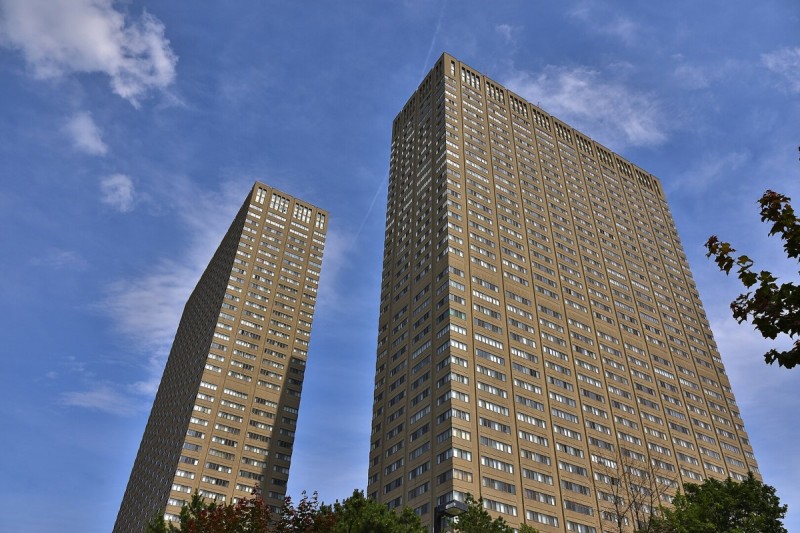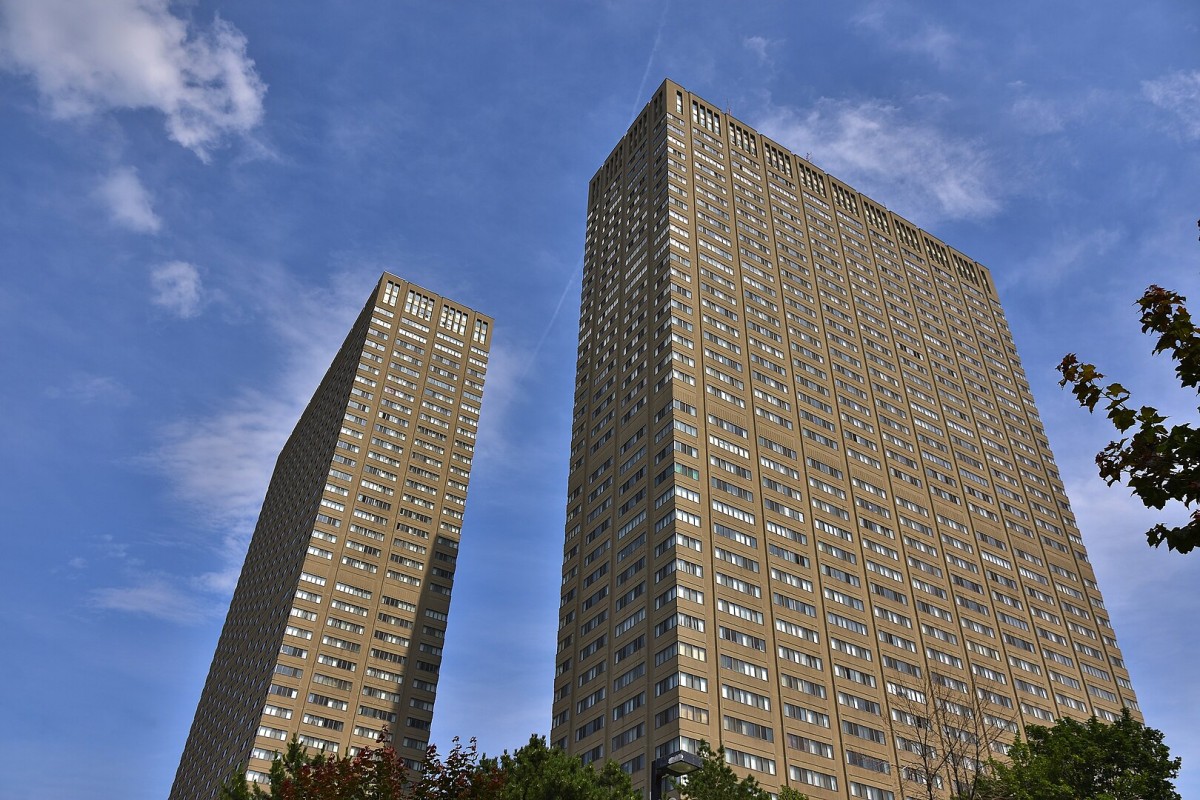
The Leaside Towers in East York, Toronto. Photo by SAF1999/Wikimedia Commons.
There’s a myth going around Toronto that everyone—tenants, politicians, even landlords—wants more affordable housing. Last month, Ontario Premier Doug Ford and his supporters in the landlord lobby group, the Federation of Rental-Housing Providers of Ontario (FRPO), finally busted it.
The Fighting Delays, Building Faster Act, introduced on October 23, is designed to fast-track housing construction and infrastructure projects by concentrating greater decision-making power in the hands of the provincial government. The government says it will also cut down the backlog at the Landlord and Tenant Board (LTB), where tens of thousands of eviction cases have piled up. However, there is nothing in the extensive proposals about landlord and tenant rights that will do anything to help with affordability. Completely the opposite: the impact will be to speed up evictions so landlords can flip affordable units and increase rents.
Tony Irwin, president and CEO of the FRPO, who was present for the unveiling of the legislation, gave away the game when he said the act will “make it easier to bring much-needed rental homes to market.” How will it do so? Not by building new public or affordable housing. Rather, by supercharging evictions of longstanding tenants, so landlords can put the same units back on the market at higher price points.
Indeed, this is the explicit business model of the most prolific landlords in Toronto. Sometimes called “financialized” landlords, these sophisticated, large corporate firms—some publicly traded, some backed by private equity or institutional investors—are buying up more and more units across Toronto. In 2020, they bought around 90 percent of the rental units sold in the city.
Nationally, Canada’s 25 largest corporate and financial landlords held about 330,000 units in private purpose-built rental apartment stock in 2020, roughly one-fifth of the entire private rental market.
This is how they usually make money: Buy buildings where tenants have lived for generations and are paying below-market rent, push them out, upgrade units, jack up rent, use now-highly-valued buildings to take out cheap loans, then use those loans to buy more buildings and pay out investors.
As a housing lawyer, I see this cycle on repeat. Landlords have a few tactics for getting rid of longstanding tenants. They let units run into disrepair, they use legal loopholes like above-guideline rent increases to price people out, or they initiate renovations that require tenants to leave for such a long period that they are forced to permanently relocate.
Large landlords do this because the key to their business model is churn. Tenants must leave for profits to increase. Recent research from the Universities of Waterloo and the University of Toronto found eviction filing rates tripled, on average, when financialized firms bought rental units. Evictions get results—financialized landlords posted rents 44 percent above neighbourhood averages from 2022-2024.
According to a new investigation by The Breach, this model has an outsized impact on racialized working class people. Their reporting found landlords appear more likely to use harassment, above-guideline increases, or drawn-out renovations to push out long-standing residents in predominantly Black and other racialized communities, turning affordable units into high-rent properties for wealthier, often white, tenants.
After years of being subjected to these tactics, Toronto renters are wise to what is happening. Tenant unions are proliferating as neighbours band together to oppose displacement. Rather than pack up and go upon receiving eviction notices, more tenants are showing up at the LTB, and elsewhere, to fight. Hundreds have staged rent strikes in protest of harassment, above-guideline increases and landlord neglect.
These efforts bungle up landlords’ plans and their promises to lenders and investors. This is what Ford’s proposals are really targeting. The goal is to silence poor and working class tenants and the organizations they’ve built, to guarantee continued churn.
Bill 60 proposes making eviction notices more threatening in hopes people move out without going to court at all. It builds on an existing scheme of procedural stumbling blocks to help landlords win evictions on technicalities. And it calls for hiring more sheriffs to carry out evictions faster, with no time for tenants to appeal or pay arrears they might owe. Not one of these proposals will add housing to the market or make it more affordable.
The government has already shown that its reforms go as far as the public will allow. After public backlash, it walked back a proposal to consult on changes to Ontario’s “evergreen” leases—rules that guarantee tenants the right to stay in their homes month-to-month after their lease expires. Housing advocates called the reversal a relief but warned that the rest of Bill 60 still represents a sweeping attack on tenants’ rights, stripping away legal protections to make evictions faster, easier and cheaper for landlords.
Ford may think that disappearing tenants and their unions from the LTB will disappear them from the city, but it won’t. Tenants and the growing tenant union movement in Ontario have been successfully utilizing the LTB to throw sand in the gears of financialized landlords’ predatory business model. Given the affordability crisis, they have no choice but to continue fighting. Ford will find that if he prevents them from doing so at the LTB, they’ll simply find a different sandbox.
Leora Smith is a lawyer and Co-Director of the Community Justice Collective (CJC), a not-for-profit legal collective providing free legal support to organized communities across the GTA. Started in 2020, the CJC has represented hundreds of tenant union members, including those on rent strike and in fights against above-guideline increases and landlord harassment.
We Need Your Help
More than 75% of our operating budget comes to us in the form of donations from our readers. These donations help to pay our bills, and honorariums for some of our writers, photographers and graphic artists. Our supporters are part of everything we do.
